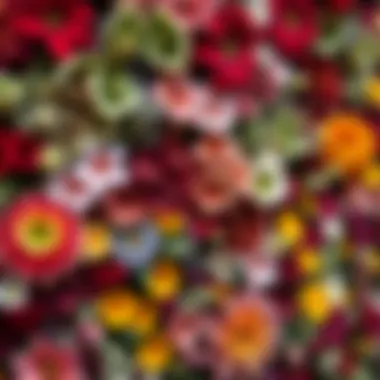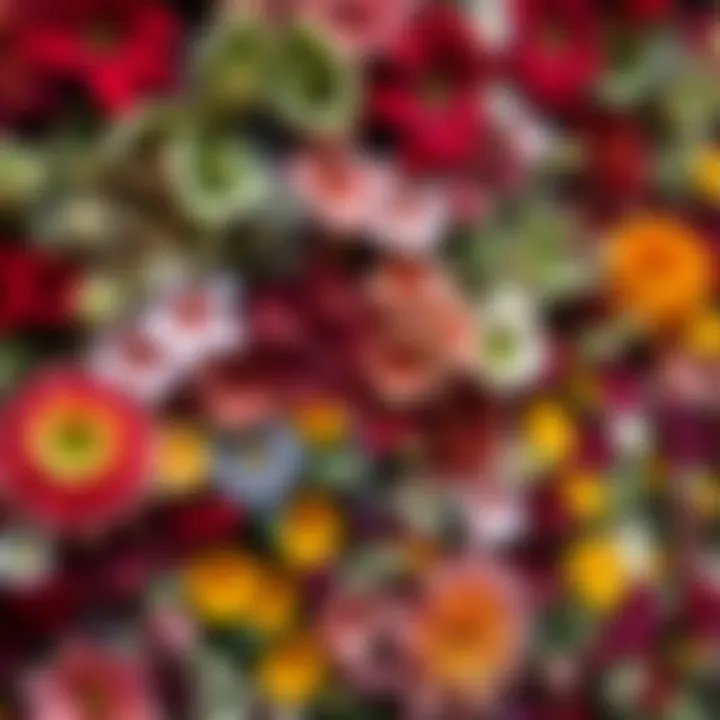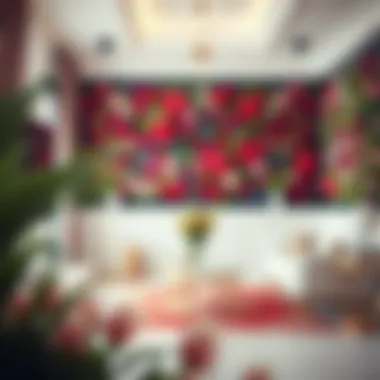Exploring Live Flower Walls: Design and Benefits


Intro
Live flower walls bring a unique charm to both indoor and outdoor spaces. They create a sense of life and vibrancy that stark walls simply can't match. Imagine stepping into a room adorned with cascading blooms or entering a garden where walls are alive with nature. These installations aren't just eye candy; they serve multiple purposes from enhancing aesthetics to improving air quality.
In this article, we are diving deep into all there is to know about live flower walls. We'll cover how to design them to suit your style, maintain them for longevity, and explore their emotional and ecological benefits. Whether you're a homeowner looking to add flair to your space, a design enthusiast itching to experiment, or a gardening aficionado with green thumbs ready for a challenge, this guide aims to equip you with everything you need to know.
Design Inspirations
When it comes to live flower walls, creativity knows no bounds. They can be a statement piece, a calming background, or an interactive display. Let's look at some of the trending styles and color palettes that are making waves in the design world.
Trending Styles
- Vertical Gardens: This style makes use of vertical space, turning often neglected walls into lush greenery displays. It's perfect for urban environments where floor area is limited.
- Modular Systems: Using panels or modules, these systems allow for flexible designs that can be easily moved or modified. They're great for people who love to change the look of their space periodically.
- Mixed Media: Some designers add unexpected elements like wood, stone, or metal to their flower walls. This approach creates textural contrast and can balance the softness of the flowers.
Color Palettes
Selecting the right colors can transform a flower wall into a cohesive and visually appealing element in your space. Here are some ideas:
- Pastel Hues: Soft pinks and blues can evoke a sense of calm and tranquility, ideal for a bedroom or meditation space.
- Bold and Vibrant: Bright yellows, reds, or blues make a statement, perfect for a lively living area or party venue.
- Monochromatic Schemes: Shades of a single color can bring a sense of sophistication while still allowing the flowers to stand out in their own way.
"The choice of flowers, colors, and arrangements can say a lot about the personality of the space and the people in it."
Maintenance and Upkeep
Just like any living element, flower walls require regular care to thrive. Understanding the basics of maintenance ensures these vibrant displays continue to impress.
Seasonal Maintenance Checklist
- Spring: Inspect for dead leaves or wilting plants and replace them. It's also time to fertilize and check irrigation systems.
- Summer: Ensure adequate watering during hot months; consider misting foliage to keep it fresh and hydrated.
- Autumn: Prepare for the cooler months; prune plants that might become leggy as they move into dormancy.
- Winter: If in colder climates, ensure proper temperature control to protect delicate species.
Cleaning and Organization Tips
Keeping your flower wall tidy is as important as nurturing the blooms. Here are some pointers:
- Regularly dust leaves using a soft cloth or a gentle vacuum.
- Organize plants by type or color for a harmonious look; it also makes identifying care needs easier.
- Routinely check for pests, as they can quickly diminish the beauty of your installation.
In summary, live flower walls are not only aesthetically appealing but also contribute positively to the atmosphere of any space. From the style of design to ongoing care, understanding these elements enhances the beauty and functionality of live plants in our environments. As we explore further, we will dive into installation techniques and delve deeper into their psychological and ecological advantages.
Preface to Live Flower Walls
Live flower walls have experienced an impressive rise in popularity, transforming both commercial and residential spaces. They offer more than just visual appeal; these vertical gardens can positively impact the atmosphere of a room and the well-being of those within it. Whether you are hosting a gathering or simply enjoying your home life, incorporating live flower walls can create a serene and vibrant environment. Their significance goes beyond aesthetics, intertwining practical benefits with emotional upliftment.
Definition and Characteristics
Live flower walls are structures that integrate living plants, particularly flowers, into a vertical arrangement. Unlike traditional gardens sprawling horizontally across the ground, these installations offer a refreshing take on how greenery can be embraced in smaller spaces, such as apartments or offices.
Characteristically, these walls can support a variety of flora—ranging from colorful blossoms to lush foliage—providing observers a dynamic display that changes with seasons. Crafted usually from modular panels or grids, a live flower wall is designed to ensure that plants receive requisite sunlight, moisture, and nutrients. This is often achieved through an integrated irrigation system or the clever placement of plants.
The textures and colors of the chosen flowers can vary dramatically, giving designers ample creative freedom. This is a unique canvas that allows for personalization, dancing along the lines of the owner's style preferences, or even the theme of a particular event.
Historical Context
The concept of utilizing vertical gardening has deep roots, often finding its way back to ancient civilizations. Ancient Rome showcased flower walls in their grand villas, using climbing plants to adorn their elaborate architecture. This trend evolved over centuries, adapting itself to suit cultural values and environmental conditions. For instance, in Asian cultures, gardens developed as reflections of harmony between humans and nature, utilizing vertical spaces to incorporate blooming flora that encouraged tranquility.
During the 20th century, interest surged again, led by advancements in horticulture and a rising eco-consciousness. The late 1970s and early 80s saw a shift towards incorporating plants into urban settings. However, it was not until the late 1990s that live flower walls captured the attention of the modern design scene, propelled by the work of horticulturist Patrick Blanc. His pioneering methods and aesthetic vision encouraged architects and interior designers to explore greener alternatives.
Today, live flower walls stand at the crossroads of innovation, sustainability, and artistry. With a renewed focus on biophilic design, these installations symbolize a movement aiming to bridge the gap between urban life and the natural world. As interest grows, it beckons us to understand their place within both the historical narrative of gardening and the modern quest for a more harmonious living space.
Types of Live Flower Walls
Live flower walls offer a creative way to integrate nature into our built environments. They not only embody aesthetic beauty but also provide practical benefits, such as improving air quality and enhancing overall well-being. This section delves into various types of live flower walls, shedding light on how each type can enrich spaces differently, along with specific considerations that come into play for homeowners and garden enthusiasts.
Vertical Gardens
Vertical gardens, often called living walls, are a striking way to utilize vertical space. They consist of a variety of plants grown on a vertical structure, allowing for lush greenery where typical garden beds may not fit. Think of them as a marriage of art and ecology; these gardens create visual interest and can be fitted with various media systems ranging from soil to hydroponics.
Benefits of Vertical Gardens:
- Space Efficiency: Perfect for small areas or urban settings where ground space is limited.
- Microclimate Creation: They help cool buildings and can reduce energy costs.
- Biodiversity Promotion: These gardens can attract local wildlife, including birds and pollinators, making them a hub for life.
When contemplating a vertical garden, consider the local climate. Some plants thrive in sunlight, while others prefer shade. This selection impacts not just aesthetics but also maintenance needs.
Moss Walls
Moss walls, which primarily feature various types of moss, are gaining popularity for their unique texture and color. These installations can be quite soothing to view and offer a sense of tranquility. Unlike more traditional plant setups, moss walls typically require less maintenance and water, making them suitable for settings that might not have optimal growing conditions.
Key Advantages of Moss Walls:
- Low Maintenance: Unlike flowering plants, moss generally needs less care and can survive in lower light conditions.
- Sound Absorption: Moss can help absorb sound, thereby creating a quieter indoor environment.
- Air Quality Improvement: Similar to other plants, moss can capture dust and particulate matter, improving indoor air quality.
Before committing to a moss wall, assess the humidity levels of the intended space, as moss generally prefers a higher humidity to thrive. This practical consideration ensures the wall remains vibrant and fulfilling its intended purpose.
Succulent Displays
Succulent displays are another exciting type of live flower wall that combines beauty with resilience. Succulents, with their thick, fleshy parts, are ideal for those who may not have a green thumb or the time to maintain high-maintenance plants. Their ability to store water and thrive in a variety of conditions makes them versatile and resilient members of any flower wall.
Reasons to Consider Succulent Displays:
- Variety of Shapes and Colors: Succulents are available in a variety of colors, shapes, and sizes, enabling unique designs.
- Drought Resistance: They're well-suited for dry regions or for people who struggle to maintain consistent watering habits.
- Playful Arrangements: With their diverse forms, they lend themselves to creative designs that can be rearranged easily.
In creating a succulent display, one should consider the materials used for the wall structure. A frame that allows for proper drainage will be necessary to keep these beauties thriving over time.
"The right flower wall can transform any dull space into a vibrant and engaging environment, putting nature at the forefront of design."
By understanding the distinctions between vertical gardens, moss walls, and succulent displays, you’re equipped with insights on how each can serve not just an aesthetic purpose but also enhance your living or working space. With the right choice tailored to your needs and location, integrating a type of live flower wall could be a beautiful step towards a greener life.


For more detailed guidance on the impact of flora on spaces, check this resource or visit the local horticulture groups available on platforms like Reddit.
Design Considerations
In the realm of live flower walls, thoughtful design considerations are keystones that determine the success and longevity of these vibrant systems. To create a visually appealing installation that contributes positively to the surrounding environment, it is vital to address several key elements when designing a live flower wall. These include selecting the right location, understanding color theory in flower selection, and recognizing the importance of size and scale.
Choosing the Right Location
The location of a live flower wall can make or break the overall aesthetic and functionality. A well-placed wall not only enhances curb appeal but also can improve indoor air quality and provide a soothing backdrop in busy spaces. Here are some factors to consider:
- Sunlight Exposure: Different plants have varied light requirements. For instance, succulents prefer bright sunlight, while shade-loving ferns thrive in low light. A thorough assessment of light patterns throughout the day helps select the right spot.
- Accessibility for Maintenance: If the wall is tucked away in a corner, it may become challenging to reach for watering or pruning. Ensuring ease of access will save time and effort, making maintenance smoother.
- Environmental Considerations: Wind exposure and humidity levels in certain areas can impact plant health. It’s critical to choose a location that aligns with the plants' needs.
"Choosing the right place for your flower wall is like picking the right outfit for an occasion; it should fit the environment and context."
Color Theory in Flower Selection
Color theory plays a pivotal role in the impact a flower wall can have on emotions and perceptions. Different colors evoke distinct feelings and can significantly influence how a space is experienced. Here are some pointers:
- Warm Colors: Hues like red, orange, and yellow can create a welcoming and energetic space. They are excellent for social areas or commercial settings where activity is desired.
- Cool Colors: Blues and greens promote tranquility. Incorporating these colors in personal spaces, like a home office, can enhance focus and calmness.
- Complementary Schemes: Mixing colors that sit opposite each other on the color wheel can create striking contrasts. This technique draws attention and can be particularly useful when designing a feature wall.
- Monochrome Options: Consider shades of a single color for a more subtle effect, which often gives a sophisticated touch, perfect for high-end settings.
Size and Scale
The size of your live flower wall is not just a matter of aesthetics; it significantly affects plant health, design coherence, and space utilization. Keep these considerations in mind:
- Proportion to Space: A small wall may get lost in a large room, while an oversized installation could overwhelm a compact space. Balance is key.
- Vertical vs. Horizontal: A taller flower wall can draw the eye upward, making ceilings appear higher, while a wider installation can create a strong foundation that anchors a room.
- Plant Density: Crowding plants too closely can lead to poor air circulation, increasing vulnerability to diseases. Conversely, too sparse a layout may fail to create that lush, vibrant look typically desired from flower walls.
By taking these design considerations into account, enthusiasts can craft flower walls that not only reflect personal style but also positively affect the environment and well-being of those who encounter them. The right approach in this phase can cultivate an enriching atmosphere, paving the way for subsequent steps in the creation process.
Installation Techniques
Installing a live flower wall is more than just planting a few flowers and calling it a day. It involves a plethora of considerations that can greatly affect both the aesthetic and the functional aspect of the wall. Understanding proper installation techniques ensures that the flower wall thrives for years to come, creating a vibrant and living art piece.
Materials Needed
Before diving into installation, gathering the right materials is essential. Here’s a list of crucial components:
- Plant Selection: Choose plants that are suitable for the specific environment. Consideration for sunlight and water needs is vital. Species like Ivy, Ferns, and Petunias can often serve well in various contexts.
- Wiring or Netting: This will support the plants as they grow. Mesh netting made from materials like polyurethane can create a sturdy foundation.
- Planters or Containers: Depending on the design, you might need vertical planters that support the growth orientation of the plants.
- Soil or Growing Medium: A good potting mix promotes healthy growth. The soil should retain moisture without becoming waterlogged.
- Watering System: Drip irrigation systems can be beneficial for maintaining consistent moisture without oversaturating.
These materials come together to establish a solid framework for nurturing the living wall.
Step-by-Step Installation Process
To ensure the installation goes smoothly, follow these steps:
- Planning the Layout: Before any digging or planting, sketch out the desired design. A visual reference helps in selecting the right pattern and plant varieties.
- Preparing the Wall: Clean the wall surface. If using a mounting for planters, install these first to ensure they're secure.
- Setting Up the Structure: Attach the netting or wiring to the wall. Make sure it’s taut to support the plants effectively.
- Adding the Soil: Fill planters or wall pockets with the prepped soil mix, leaving some space for the plant roots.
- Planting: Arrange the plants according to your design. Ensure each plant is adequately spaced to allow for growth.
- Watering: After planting, give the wall a thorough watering to help the plants settle into the new soil.
- Maintaining the System: Make sure the irrigation system is operational, if using one, and monitor it for efficiency.
"A well-installed flower wall not only beautifies but also elevates the space, making it a sensory haven!"
Professional Installation vs. DIY
When it comes to installation, the question of whether to go the DIY route or hire professionals often arises. Here are points to consider for each:
- DIY Approach:
- Professional Installation:
- Cost-Effective: Doing it yourself can save on labor costs.
- Customization: You have complete control over design and materials, allowing for personal creativity.
- Skill Development: It’s an excellent way to learn about plant care and gardening.
- Expertise: Professionals bring experience, which can lead to a more polished and successful outcome.
- Time-Saving: A skilled team can complete the installation promptly, often within a single day.
- Guarantee of Work: Many professionals offer guarantees, providing peace of mind regarding the longevity and health of your installation.
Ultimately, the choice depends on your budget, the complexity of the design, and your own confidence in your gardening skills.
Whether you are a seasoned homeowner sprucing up your space or a first-time gardening aficionado, understanding these installation techniques can turn your flower wall dream into a flourishing reality.
Maintenance Requirements
Caring for live flower walls is not only about aesthetic appeal; it's integral to their functionality and longevity. Proper maintenance ensures that your green installation thrives, contributing to both your indoor or outdoor environment and your emotional well-being. Like a good dish requires careful seasoning, a flower wall requires thoughtful nurturing to flourish. Neglecting maintenance can lead to withering plants or a garden gone awry. Let’s break down the essentials of keeping your vibrant scene alive and kicking.
Watering Techniques
When it comes to watering live flower walls, understanding the individual needs of each plant species is key. Overwatering can lead to root rot, while underwatering leaves plants parched and droopy. A hands-on approach often helps. For example, moisture meters can help gauge when it's time to water again, allowing you to avoid guesswork.
In general, here are a few practices to consider:
- Consistent Schedule: Aim to stick to a routine, watering either every few days or weekly.
- Drip Irrigation: This method delivers water directly to the plant's roots, minimizing waste and ensuring even hydration.
- Observation: Keep an eye out for yellowing leaves or wilting; these may signal a need for more or less water.
"The key to a flourishing flower wall starts from the ground up—literally!"
Fertilization Strategies
Feeding your flowers is as crucial as watering them. Fertilization provides essential nutrients, promoting blooming and growth. Oftentimes, neglecting fertilization leads to lackluster plants that don't reach their full potential. A common firs step is choosing the right fertilizer—liquid, granular, or slow-release.
Here’s how to nail down a strategy:
- Soil Test: Begin with a soil test to identify nutrient deficiencies. This will guide your fertilization approach.
- Timing: Fertilize during the growing season to maximize impact. Generally, late spring to early summer is ideal.
- Organic vs. Synthetic: Whether you choose organic fertilizers or synthetics should be based on personal preference and specific plant needs.
Pest Management
Pests can bring a flower wall from thriving to surviving in no time. Keeping an eye out for insects, such as aphids and spider mites, is essential. Early detection can save the day, preventing significant damage. Integrated pest management often proves to be effective in maintaining plant health.
Consider these pest management strategies:
- Diverse Planting: Include a mix of plants that naturally repel pests, reducing the chance of infestations.
- Regular Check-Ups: Inspect leaves and stems frequently for any signs of trouble. A proactive approach often yields better results.
- Natural Remedies: For minor infestations, consider using soap sprays or neem oil to mitigate the issue without harsh chemicals.
Maintaining a live flower wall is certainly an endeavor ripe with responsibilities. Adhering to proper watering, thoughtful fertilization, and keen pest management will ensure that your wall remains a lively, green spectacle and a source of pride.
Environmental Impact


When discussing live flower walls, it's essential to weigh their environmental impact. These installations do not merely serve aesthetic purposes; they hold significant ecological benefits that contribute to sustainability and wellness in both urban and rural settings. Understanding the broader implications of these living features can elevate their value in home and commercial design.
Biodiversity Enhancement
One of the standout benefits of live flower walls is their potential to enhance local biodiversity. By providing a habitat for various species, flower walls can turn ordinary spaces into thriving ecosystems. For instance, when you incorporate native plants, it attracts local pollinators like bees and butterflies. These creatures play an invaluable role in pollinating food crops, which in turn supports the food chain.
Moreover, flower walls can serve as stepping stones for wildlife. In urban environments where natural habitats are scarce, they can connect patches of greenery, facilitating the movement of species and promoting genetic diversity. For the environment, fostering biodiversity is crucial. It strengthens ecosystems, making them more resilient to changes.
"Urban environments can transform into biodiversity hotspots simply by re-imagining how we use space. Live flower walls can provide a lifeline for nature, even in the heart of the city."
Air Quality Improvement
Another significant factor in the discussion about live flower walls is air quality improvement. Plants, as part of their natural processes, absorb carbon dioxide and release oxygen, which is fundamental for our survival. When installed correctly, these walls act like a breath of fresh air for both indoor and outdoor spaces. Studies reveal that incorporating greenery into living or working environments can greatly reduce indoor pollutants.
Furthermore, plants can filter toxins from the atmosphere. For example, certain varieties remove chemicals like formaldehyde and benzene, common in industrial environments. Thus, a well-maintained flower wall not only extends the visual appeal but also purifies the air we breathe, contributing to healthier living spaces.
List of plants that can significantly improve air quality include:
- Spider Plant
- Peace Lily
- Bamboo Palm
- Boston Fern
In summary, the environmental impact of live flower walls is two-fold: they enhance biodiversity and improve air quality, thus making them not just a beautiful addition to spaces but also an environmentally responsible choice for homeowners and designers alike.
Psychological Benefits of Live Flower Walls
Creating an inviting space often goes beyond mere aesthetics; it involves crafting an environment that promotes well-being and mental clarity. Live flower walls can play a pivotal role in achieving this. Their vibrant colors and rich textures breathe life into a setting, serving not just as decor but as a calming presence that can significantly influence our mood and productivity. Let's dive deeper into two substantial psychological benefits presented by these floral innovations.
Stress Reduction
Stress is a facet of modern life that many grapple with daily. Environments saturated with greenery, like those graced by live flower walls, have been associated with lowering cortisol levels, which is the body’s primary stress hormone. Being surrounded by nature or nature-inspired designs tends to evoke feelings of calmness and peace. A wall filled with blossoms, for instance, could almost serve as a natural antidote to the hustle and bustle of everyday life.
Studies have shown that simply viewing plants can yield a relaxation response, effectively taking the edge off stressful situations. Consider the scenarios where a live flower wall adorns the entrance of a workplace or a wellness center; the very act of walking past such installations can elicit a sense of tranquility, creating a soothing transition into spaces often filled with high-stakes decisions.
Moreover, the act of nurturing plants often contributes to reducing mental strain. When individuals engage with their floral spaces, watering or pruning becomes a meditative task, allowing them to focus on the intricacies of care rather than the worries that may plague them. Thus, live flower walls not only beautify the surroundings but also offer respite for frayed nerves.
"Nature has the power to replenish the soul, and leveraging that with a floral wall creates serenity in spaces where it’s needed most."
Increased Creativity
In addition to alleviating stress, live flower walls can be catalysts for creativity. The presence of vibrant colors and varied plant forms stimulates the brain, sparking inspiration and fresh ideas. Just think about how creative industries often seek spaces with abundant natural light and greenery. This setup allows minds to wander and roam freely, decreasing the natural barriers we impose on our thoughts.
The concept of biophilia – our innate affinity for nature – suggests that surrounding ourselves with live flora can amplify creative thinking. For instance, a company that incorporates a flower wall in its brainstorming room may notice that discussions flow more freely and ideas develop with greater ease. The visual impact of such a space encourages out-of-the-box thinking.
Furthermore, the unique interplay of flowers, design, and light casts an ever-changing canvas. As the seasons cycle through different blooms, our perspectives can shift too, providing new viewpoints that inspire innovative solutions. Ultimately, live flower walls work as a vivid backdrop, subtly nudging individuals towards creative breakthroughs in various settings.
In summary, live flower walls do much more than enhance physical spaces. They have profound psychological benefits worth considering. Whether it’s reducing stress or boosting creativity, these vibrant installations prove to be valuable investments in both professional and personal environments.
Suitable Plant Options for Flower Walls
When it comes to live flower walls, selecting the right plants is like picking the right ingredients for a gourmet recipe. The plants you choose not only influence the aesthetic appeal but also impact maintenance needs, growth habits, and how well they adapt to their environment. Getting this selection right requires careful consideration of several factors including sunlight, moisture, and climate. As such, exploring suitable plant options for flower walls is crucial for any homeowner or garden enthusiast eager to create a visually stunning and functional green space.
Flowering Plants
Flowering plants are the heart and soul of any lively flower wall. They bring color, texture, and an undeniable vibrancy to both indoor and outdoor setups. Some popular options include:
- Petunias: These are versatile and bloom throughout the season. Their layered petals provide a luscious look.
- Begonias: Known for their hardiness, begonias thrive in partial shade, making them perfect for less sunny spots.
- Fuchsias: With their delicate, hang-down blooms, fuchsias can create a striking aesthetic, especially when used in vertical arrangements.
When choosing flowering plants, think about the color palette you desire. A mix of bold and soft hues can create depth, while similar tones can result in a more uniform look. Additionally, pay attention to blooming seasons; having a combination of early bloomers and late bloomers can ensure your wall remains colorful year-round.
Perennials vs. Annuals
The choice between perennials and annuals is a significant aspect of plant selection. Let’s break it down:
- Perennials: These plants return year after year. Examples like lavender or coneflowers can establish a robust, lasting flower wall with minimal upkeep. The advantage here is that once they’re well-placed, you won’t need to replant each season. However, their initial establishment might take longer than annual plants.
- Annuals: On the flip side, annuals like marigolds or zinnias provide immediate color but require replanting each year. They often bloom abundantly and can be switched out easily based on seasonal themes or events, allowing for versatility in your design.
Choosing between these types often involves balancing commitment against flexibility. Both have their perks and can coexist beautifully in the same flower wall, creating variety in both texture and color through the seasons.
"The key to a thriving flower wall is not just about what looks good, but also what will thrive given the specific conditions of your space. Be mindful of growth habits and environmental preferences."
Budget Considerations
Budget considerations play a pivotal role in the implementation of live flower walls, allowing homeowners and designers alike to make informed decisions. The intricate relationship between aesthetic desires and financial feasibility can’t be overlooked. Taking a comprehensive approach to budgeting not only ensures the longevity of the installation but also enhances overall satisfaction with the outcome.
Many people dive in head first, eager to craft a floral masterpiece, but it’s crucial to do the math on materials and maintenance right from the get-go. Understanding the costs involved not only prepares you for the upfront expenditure but also aids in managing long-term upkeep which can be quite a surprise if not planned for.
Cost Analysis of Materials
The world of live flower walls offers a variety of materials, each with its unique price tag. Selecting the right ones can make or break your budget. Here are a few considerations:
- Plant Choices: Different plants come at different prices. For example, flowering plants such as orchids and ferns may cost significantly more than hardy succulents or moss. If you’re on a tight budget, opting for perennial varieties can save money in the long run since they return year after year.
- Framework and Support: Materials for the structure itself, often overlooked, can vary greatly. Wooden pallets are cost-effective and can provide a rustic charm, whereas metal frames might be pricier but offer greater durability and a modern look.
- Growing Medium: The choice of soil or hydroponic systems can greatly influence the total cost. Soil can be cheaper initially but might require frequent replacements while a hydroponic system can be a larger investment upfront but can save on ongoing soil costs.
- Watering Systems: If you’re considering a drip irrigation system, factor in not only the initial costs but also the installation and ongoing water bills.
This careful assessment of costs can help avoid unforeseen financial strain down the line.
Ongoing Maintenance Costs
Budget doesn’t just end at installation; ongoing maintenance costs are essential to comprehend as well. Just like a fine car, a live flower wall requires regular attention and investment:
- Watering: Depending on the plants you've chosen, your watering needs might vary. Succulents have low water requirements, while tropical plants may need more frequent hydration.
- Fertilizers: Quality fertilizers may seem like an added expense, but they are crucial for maintaining plant health. Prices can range from affordable options to pricey organic varieties, depending on your approach to care.
- Replacement of Plants: Over time, certain plants may not thrive due to environmental changes. Budgeting for occasional replacements ensures that the wall remains lush and vibrant.
- Pest Control: Depending on your region, pest management can become a recognizably ongoing cost. Using natural pesticides might be pricier initially but could preserve the integrity of your garden in the long run.
"Taking an honest look at ongoing costs ensures that your beautiful flower wall doesn't become a financial burden over time."
In summary, thorough budgeting from the start, both for initial installation and ongoing maintenance, can significantly impact the overall success of your live flower wall project. It ensures that you not only stay within financial limits but also enjoy your installation for years to come.
Cultural Significance in Different Regions
The cultural significance of live flower walls stretches far and wide, transcending geographic borders and echoing the essence of local traditions and practices. These vibrant displays are not just visual spectacles; they encapsulate much of the social and historical fabric of a community, often symbolizing harmony with nature, celebration of life, and sometimes even spiritual connections.


Historical Context and Traditions
Dating back centuries, various cultures have utilized floral displays to mark significant occasions or rituals. For instance, in ancient Hindu traditions, flowers play a pivotal role in worship and celebrations. Temples would often adorn their walls with intricate floral designs, reflecting not just artistry but also a deep reverence for nature. Similarly, in Japanese culture, the practice of Ikebana emphasizes not just arrangement but the philosophical essence of each flower, creating walls of blooms that resonate with a meditative quality.
In Mediterranean regions, vibrant flower walls are often associated with local festivals. Regions like the Amalfi Coast in Italy utilize cascading blooms on their terraces and public squares during festivals, integrating the natural world into their celebrations and enhancing community identity. It’s a vivid representation of how flowers have historically bridged the gap between nature and human expression.
Modern Adaptations Across the Globe
In our contemporary era, the adaptability of live flower walls remains striking. Urban areas around the world have embraced this living art form, transforming bare cityscapes into floral exhibitions. For example, cities like Singapore have taken it a step further with vertical gardens that meld aesthetics with environmental purposes, contributing to urban air quality and biodiversity.
The trend of incorporating floral walls into business spaces is also gaining traction. Cafés and boutiques across Europe and North America leverage these lively displays not just for decoration but as a branding tool. They create immersive environments and environments that allure customers in a bustling commercial landscape. This modern adaptation illustrates the versatility and functional application of flower walls in enhancing both aesthetic and commercial value.
"A flower wall does more than beautify a space; it serves as a canvas that showcases the history and culture of a region while further connecting individuals to the environment around them."
In the Middle East, flower walls are being integrated into architectural designs' traditional and modern counterparts. Here, they reflect hospitality and warmth, giving a fresh take on age-old traditions while creating aesthetically pleasing spaces for gatherings.
Such adaptations signify a broader narrative where communities are coming together to recognize the impact of nature on their living spaces. The cultural significance of live flower walls is a thread connecting history, community, and creativity, allowing for both appreciation of past customs and innovation in modern design.
Live Flower Walls in Commercial Spaces
Live flower walls have carved out a niche that goes beyond mere decoration in commercial spaces. They serve various functions, transforming the ambiance within businesses and creating unique narratives that resonate with clients and customers alike. By integrating live flower walls into their environments, businesses can enhance spaces in ways that foster positive experiences and strengthen brand identity.
Enhancing Customer Experience
In an age where consumer experience is paramount, live flower walls emerge as a potent tool for businesses aiming to elevate their interaction with customers. Imagine stepping into a cafe where an expansive wall brimming with vibrant, blooming plants sets the mood before you even order. This not only improves the aesthetic appeal, but also stimulates the senses, making customers feel more relaxed and connected.
- First Impressions Matter: The initial encounter a customer has often shapes their overall opinion about a business. A striking live flower wall can captivate attention instantly, creating a welcoming atmosphere.
- Natural Ambiance: The presence of greenery contributes to a calming environment, beneficial in high-stress settings like waiting rooms or urban eateries.
- Encouraging Longer Stays: Retail environments with lush floral displays might encourage customers to linger longer, which often translates to increased spending. The visual interest draws people in and might even inspire them to capture the moment, thus amplifying organic marketing through social media.
"A well-placed flower wall can be the difference between a passerby and a potential loyal customer."
Branding and Identity
The incorporation of live flower walls is not just about adding color; they also play a critical role in reinforcing a brand's identity. Each stem, petal, and leaf can be curated to align with a company’s ethos, making them synonymous with the brand itself.
- Color Schemes and Themes: Just as logos and branding materials adhere to specific color codes, the hues of flowers used can complement brand colors, solidifying visual identity. For instance, a brand associated with eco-friendliness could opt for succulent walls or native plants, enhancing authenticity.
- Storytelling: Flower walls can embody a narrative that resonates with consumers. A wine bar, for instance, might choose grapevines and herbs in their arrangements, emphasizing their commitment to quality, local sourcing.
- Seasonality: Regularly updating flower walls with seasonal blooms or themed decorations can keep consumers coming back, sparking curiosity about what is new. This constant refreshment creates an engaging and dynamic atmosphere.
Case Studies
Examining case studies provides invaluable insight into the practical applications and transformative effects of live flower walls. These examples illustrate how innovative designs can breathe life into various environments, showcasing not just aesthetic beauty but also functional benefits. By dissecting real-world implementations, readers can glean inspiration and learn from the successes—and challenges—faced by other enthusiasts and professionals.
Successful Implementations
Successful implementations of live flower walls often act as beacons of creativity and functionality. For instance, a renowned hotel in downtown Los Angeles transformed an otherwise dull atrium into a lush retreat by installing a towering vertical garden. This particular design utilized a mix of native California plants, which not only reduced water consumption but also attracted local butterflies, enhancing the charm of the space. Guests often commented on the elevated atmosphere, transforming a simple walk through the lobby into a refreshing experience.
Another noteworthy example comes from a corporate office in San Francisco, where a live flower wall serves as a backdrop for meetings. Made up of diverse succulents and vibrant flowering plants, this wall not only acts as a stunning art installation but also plays a role in improving air quality. Employees reported feeling more productive and inspired in their work environment, thanks to the splash of color and touch of nature.
Lessons Learned
Through these successful implementations, several lessons learned emerge clearly:
- Plant Selection is Key: Choosing plants that thrive in specific environments is crucial. For both the hotel and the office, selecting native or drought-resistant plants became a priority to minimize maintenance and maximize durability.
- Integration with Space Aesthetics: A well-designed flower wall should seamlessly blend with the surrounding decor. In the hotel atrium, for instance, the vertical garden was designed to reflect the overall theme of the establishment, making the integration feel organic rather than tacked-on.
- User Engagement: Involving users in the design process can lead to better outcomes. In the office setting, employees were invited to contribute ideas on the types of plants they wanted, fostering a sense of ownership and pride in their workplace.
To sum it up, case studies expose the intricacies of installing live flower walls by revealing both triumphs and missteps. Through examining these narratives, homeowners, designers, and gardening aficionados alike can recognize patterns that emphasize the importance of thoughtful planning and execution. As many have learned, the journey of implementing a live flower wall is as rich as the blooms themselves.
Future Trends in Live Flower Walls
As the world of design evolves, so do the concepts surrounding live flower walls. These living structures provide not just visual appeal, but also a multitude of benefits that range from environmental advantages to enhancing mental well-being. In an era where sustainability and aesthetics go hand in hand, understanding the future trends of live flower walls is not only timely but also crucial for homeowners and designers alike.
Technological Advances
In today's fast-paced world, technology continues to break down barriers, dramatically changing how we interact with our environments. Innovations in hydroponics, irrigation systems, and vertical gardening techniques are at the forefront. The integration of smart technology into live flower walls allows for automated watering systems that use sensors to monitor moisture levels. This reduces water waste and optimizes plant growth, leading to healthier walls with vibrant, lush flora.
Moreover, augmented reality (AR) applications are revolutionizing how designers visualize live walls before installation. Homeowners can now use AR apps to see how different plants will look in their space, making it easier to experiment. This personalization adds significant value, tailoring spaces to individual tastes without the guesswork.
On top of that, LED lighting specifically designed for plant growth is making waves. These lights can simulate sunlight, allowing for greater flexibility in plant choices and placement, extending the possibilities for indoor live flower walls.
Benefits of Technological Advances:
- Efficient water management reduces costs.
- Enhanced plant health leads to longer-lasting installations.
- Ability to visualize designs increases homeowner satisfaction.
Shifts in Aesthetic Preferences
With society increasingly leaning towards well-being and eco-friendliness, the way people perceive flower walls is transitioning. Current trends show a preference for more naturalistic designs with native plants that resonate with the local ecosystem. This shift not only minimizes maintenance but enhances biodiversity, allowing spaces to teem with wildlife.
Additionally, there’s a growing fascination with complex, layered textures. Homeowners are opting for mixed displays featuring various plant types and colors, creating walls that tell a story. Instead of uniformity, individuality is the name of the game.
Textures that change with the seasons are particularly appealing; imagine a wall that blossoms in hues of pink and yellow during the spring and shifts to rich autumn tones. This kind of evolution in aesthetics keeps spaces dynamic and engaging, something that is highly valued in both residential and commercial settings.
Considerations for Shifts in Aesthetic Preferences:
- Choose plants that thrive in your local climate.
- Think about seasonal variations for dynamic visuals.
- Experiment with varied textures for an enriched aesthetic experience.
Live flower walls are not just an extension of garden art; they reflect a cultural shift towards eco-conscious living, individual expression, and technological integration in everyday spaces.
Incorporating these future trends into live flower walls not only enhances their beauty but also aligns them with the values of sustainability and personal expression in design.
Ending
The importance of live flower walls in both design and environmental contexts cannot be overstated. The culmination of aesthetics, functionality, and ecological benefits makes them stand out in modern landscaping and interior design. In a world that increasingly values sustainability, embracing live flower walls can enhance not only individual spaces but also contribute to broader ecological wellness. They serve as a living testament to the beauty that nature provides while ensuring that indoor and outdoor spaces resonate with vibrancy and life.
Recap of Key Points
- Aesthetic Appeal: Live flower walls add a dynamic and appealing visual element to spaces, inviting beauty and natural warmth.
- Psychological Benefits: Exposure to greenery can reduce stress levels, promote creativity, and enhance overall well-being.
- Environmental Benefits: These installations can improve air quality and support biodiversity by providing habitat for various species.
- Practical Aspects: Choosing suitable plants, understanding maintenance requirements, and installation techniques are critical for sustaining flower walls effectively.
Final Thoughts
In many ways, live flower walls are more than just decorative elements. They are a bridge connecting us with nature, right in our backyards or within the confines of our homes. As homeowners, interior design enthusiasts, and gardening aficionados explore the potential of live flower walls, they must consider their long-term viability, aesthetic integration, and the immense joy they bring. By cultivating these living installations, they foster not only beauty but also a deeper appreciation for the natural world. As technology and design continue to evolve, the future of live flower walls appears not only promising but essential in our quest for a greener, more harmonious life.
"Nature does not hurry, yet everything is accomplished." - Lao Tzu
To learn more about the benefits of plant-based designs, read more at Wikipedia and Britannica.







